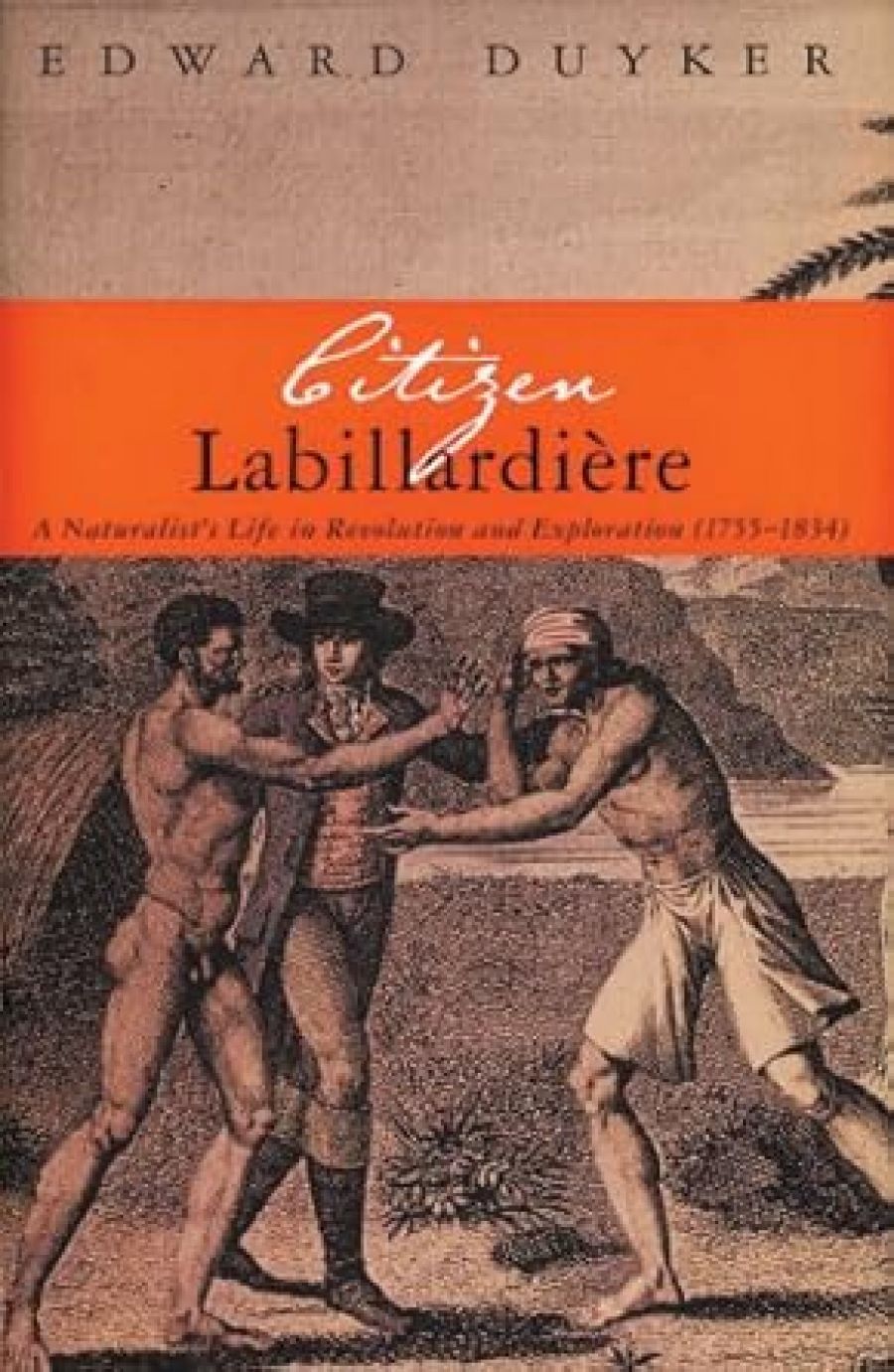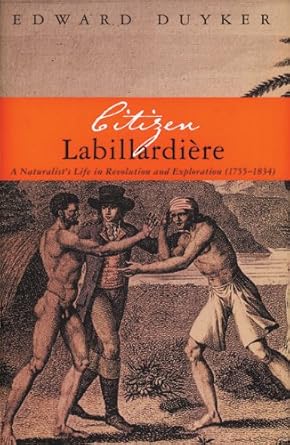
- Free Article: No
- Contents Category: Biography
- Review Article: Yes
- Article Title: Too Many Captain Cooks
- Online Only: No
- Custom Highlight Text:
We who have a colonial past may not remember, nor want to remember, that our forebears had an attitude towards the French something akin to the attitude currently being shown towards them by those thugs in the White House and the US fast-food chains who have declared that they will stop adding to global obesity with ‘french fries’ and do it instead with ‘freedom fries’.
Our French past – our brilliant French past – has been sadly neglected. Possibly because, as one of our first people sharply observed, ‘Too many Captain Cooks’, but also be-cause old political hatreds dig deep and last long. We owe much to a small band of scholars – notably Edward Duyker – who have virtually grabbed us by the back of the neck and said: ‘Look at these people. They are your history. You will see their names all over the continent. You can’t go far into the bush without seeing a plant, a tree or an animal that these Frenchmen have put on the Tree of Knowledge.’ Duyker might add: ‘Look at the floral emblems of Victoria, Tasmania, Western Australia and the emblem for the Centenary of Federation, you will - Book 1 Title: Citizen Labillardière
- Book 1 Subtitle: A naturalist’s life in revolution and exploration (1755-1834)
- Book 1 Biblio: Miegunyah Press, $59.95 hb, 408 pp
- Book 1 Cover Small (400 x 600):

- Book 1 Cover (800 x 1200):

Duyker’s latest contribution to our knowledge of the French in Australia is a biography of Labillardière, the natural historian on board Bruny d’Entrecasteaux’s 1791–93 expedition. D’Entrecasteaux led the Recherche and Espérance – more names on our maps – in an unsuccessful attempt to discover a lost La Pérouse. (They passed the island of Vanikoro without stopping.) D’Entrecasteaux’s was hardly an unsuccessful voyage, though. Labillardière’s Relation du voyage à la re-cherche de La Pérouse ... (Paris, an VIII [1800]) would be enough to redeem it all. And his Novae Hollandiae plantarum specimen … (Paris, 1804–6) and Sertum astro-caledonicum (Paris, 1824–25) are masterpieces.
Could I ask you whether you noticed the publication date of Relation du voyage? (Paris, an VIII [1800]). Labillardière would have enjoyed our insisting on that. Duyker’s biography is entitled Citizen Labillardière. All these events take place during the turmoil of the French Revolution. Labillardière sets off with d’Entrecasteaux just as the violence of the revolution begins, but its idealism still holds. Labillardière is citizen to these ideals. His ‘political correctness’, as one French biographer rather sniffily calls it, makes him unpopular on d’Entrecasteaux’s ship. Most of the navy officers are monarchists. They have a poor choice: go into exile or join a dangerous expedition. The Great Cabin of the Recherche is not a happy place, and Labillardière’s complex character and sharp tongue make it even unhappier. He drives them all mad by insisting that they use the new calendar of the revolution.
I once heard the eminent American historian Professor Bernard Bailyn tell an academic audience that included the winners of nine Pulitzer Prizes in History that biography is easy. They were not amused. They all thought biography a hard discipline. What Bailyn meant, I think, was that biography has a frame – the term of a natural life. It begins and ends. In other sorts of history, you have to invent the frame. You have to invent the beginnings and endings. Duyker takes that easy path in his biography. He begins with Labillardière’s birth in 1755, at Alençon in lower Normandy, and takes it to his burial in 1834 in Paris, aged seventy-nine, a long life in those days. Duyker suggests that Labillardière’s final resting place is appropriate. It is in a cemetery on chemin des Anglais (Joseph Banks and Labillardière are deeply involved in one another’s work) and avenue des Acacias (Labillardière named several species of wattle). Seventeen chapters follow his birth, first on his early education and then on his botanical travels – England, Lebanon, the Alps, Crete, Tenerife, Cape of Good Hope, Van Diemen’s Land, New Caledonia, Amboin, the Western Australian south-west coast.
Labillardière returns to a revolutionary France from the d’Entrecasteaux expedition at the height of the Terror. His friends are gone or going due to the Terror’s razor or suicide. His vast collection from the d’Entrecasteaux expedition is taken to England – to the care of Banks – and then tediously retrieved. Queen Charlotte liked it. Getting it back was awkward.
If Labillardière is not a darling of the revolution, at least he is trusted. Napoleon, now Bonaparte, having squibbed fighting the insurgents in the Vendée, is looting Italy. He needs someone to take all his booty back to France. Labillardière is sent as commissioner. It makes awful reading to see what he takes: from the Milan Ambrosian Library, manuscripts of Leonardo da Vinci, Petrarch and Galileo; and paintings by artists such as Michelangelo, Corregio, Rubens, Raphael and Giorgione. Whole libraries. And, of course, botanical and scientific collections of all sorts.
Citizen Labillardière is a gentle read. Duyker is an historian’s historian. Where there is no direct documentation, he is always in lateral pursuit. So the book is full of wonderful word images of culture and nature. Great names are constantly passing by – Cuvier, Diderot, Lamark, Linnaeus, James Edward Smith – but it is not a passing parade. Duyker, without much allusory show, puts them all in scene.
Of course, the botany is always centre stage. The science of it won’t dismay a reader. There is something wondrous about seeing Tasmanian forests and Western Australian shore-lines through eyes that can see how new and different it all is. Perhaps you won’t get to like Labillardière, but you will certainly like his friend Claude Riche. At one time, Riche loses himself for days alone in south-west Australia. The expedition is about to abandon him there. Labillardière pulls out James Cook’s journals and shows how long Cook was prepared to wait for men who were thought to be lost. Luckily for Riche, this shames the Great Cabin. They wait till he comes in.
There is an energy and focus among these botanists that seems extraordinary. Duyker quotes from Charles Kingsley’s Glaucus (1855) on the qualifications required for a naturalist: Our perfect naturalist should be strong in body; able to haul a dredge, climb a rock, turn a boulder, walk all day, uncertain where he shall eat or rest; ready to face sun and rain, wind and frost, and to eat or drink thankfully anything, however coarse or meagre; he should know how to swim for his life, to pull an oar, sail a boat, and ride the first horse which comes to hand, and finally he should be a thoroughly good shot, and a skillful fisherman; and if he go far abroad, be able on occasion to fight for his life.
Labillardière liked to dress in his citizen’s understated clothing. It got up officers’ noses. Maybe he is not so tattily dressed as Riche, but he should have been to have done all the things he did. Here is how a mutual friend described Riche and all that was needed to discover a micro-world in a macro-continent:
A large canvas vest, furnished with pockets front and back serves him as clothing; an immense portfolio in the guise of a shooting pouch rests over his loins; a mineralogist’s hammer hangs below, another string over the other shoulder suspends forceps padded with linen, which are destined to catch insects and butterflies; a pincushion covered with pins, long and fine, is attached to his buttonhole; a sabre or cutlass lies to his side. An umbrella-like broad-brimmed leather hat shades his head and protects his shoulders, leather gaiters ward his legs from all which can wound; and a gun usually serves to complete the equipment.
All this and much more is Duyker’s way of bringing our French past into our present.


Comments powered by CComment